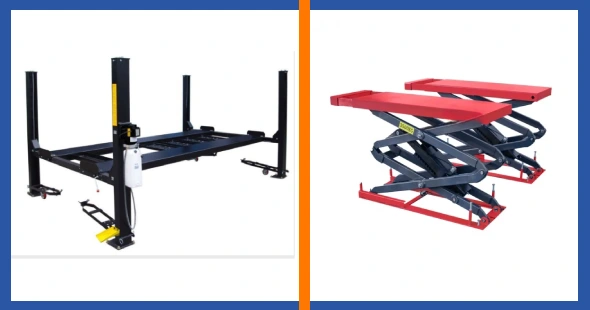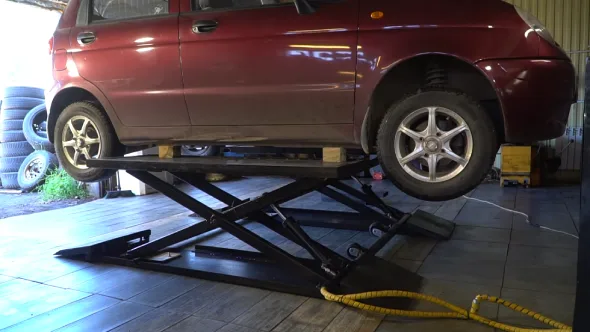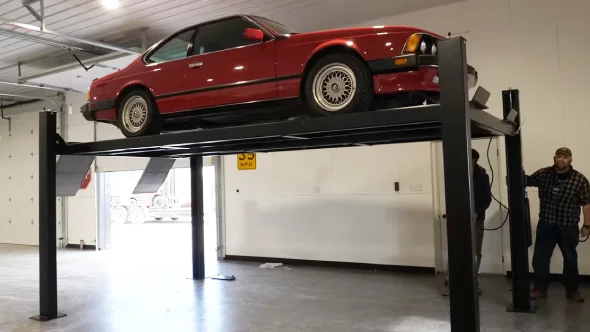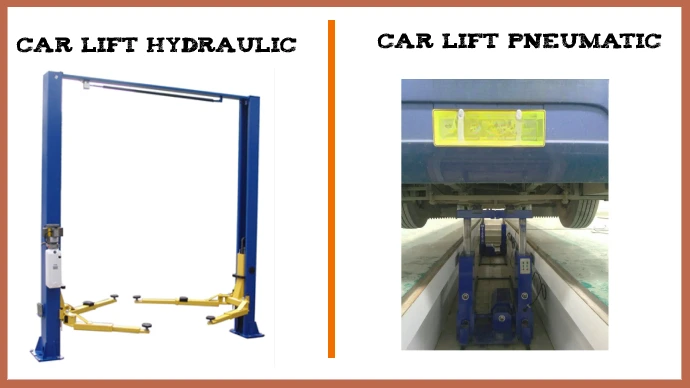Last Updated on April 12, 2023
When getting ready to equip your garage with a car lift, you want one that will be secure and reliable. You may have heard of hydraulic or pneumatic lifts but are unsure which kind is better for your needs.
Pneumatic lifts use compressed air to raise and lower the lift, while hydraulic lifts use hydraulic fluid.
Hydraulic models are the go-to choice in many auto shops due to their power efficiency, convenience, and durability, making them an ideal investment.
Read on as we break down all there is to know about both types of lifting systems so you can feel confident when deciding which one best suits your needs.
Is a Car Lift Hydraulic or Pneumatic: What Are the Differences?

Get ready to dive into the two types of car lifts and discover how hydraulic vs. pneumatic systems can make a difference in your garage setup. Check out which one works for you:
1. Power Source
Hydraulic lifts are a marvel of modern engineering, combining the powerful punch of hydraulic fluid with an electric-powered pump to lift vehicles.
You can do that, just press a button and watch as tons are raised on your command. The operators even have total control over the direction and speed thanks to valves regulating their flow.
On the other hand, pneumatic lifts rely on compressed air to power their lifts. This compressed air is stored in a tank and then is released upon activation through valves that control its direction and speed.
2. Lifting Capacity
The lifting capacity for both types of car lifts also differs significantly. For the most part, hydraulic lifts tend to have a greater lifting capacity than their pneumatic counterparts since the hydraulic fluid is less compressible than air.
This means you can safely lift heavier vehicles using a hydraulic lift without putting too much strain on the system.
On the flip side, pneumatic lifts may not be able to handle very heavy loads as efficiently as hydraulic ones could due to their lower lifting capacity.
3. Lift Speed
Pneumatic car lifts tend to be faster than hydraulic car lifts since compressed air can be delivered much more quickly than hydraulic fluid. This makes them ideal for quick servicing applications such as oil changes or tire rotations where speed is essential.
Also, pneumatic systems can achieve a rapid acceleration rate due to their smaller size and weight compared to bigger hydraulic systems, which require more time to reach full operational speed.
4. Maintenance
Both types of car lifts require regular maintenance. Despite this, pneumatic lifts require less maintenance than their counterparts. They have fewer moving parts and don’t need to replace hydraulic fluid as often as traditional hydraulic systems.
Pneumatic systems also tend to be easier to troubleshoot as all valves must be functioning properly for them to work correctly. Hydraulic systems have multiple parts that have to work perfectly for them not only to work but also to be safe.
Since there aren’t any fluids involved with running a pneumatic car lift, there’s less chance for leaks or other issues common with hydraulic lifts.
5. Cost
The cost of an automotive lift can vary depending on the type and features you choose, but generally speaking, pneumatic lifts tend to be cheaper than hydraulic ones.
This could be due to their simpler design or the fact that they don’t require replacement parts like pumps or reservoirs for regular operation.
Since pneumatic lifts usually require less maintenance over time than hydraulic ones, this can save money in the long run by cutting down on servicing costs.
Regarding the cost and maintenance of car lifts, several factors should be considered before making a purchase decision.
Pneumatic lifts tend to offer lower upfront costs than hydraulic systems while also requiring less maintenance over time. However, they may not always have the same level of power or range as some more expensive models with more advanced features.
Ultimately it’s important to weigh all your options carefully before deciding what’s right for you and your vehicle needs.
How Does the Hydraulics Work on a Car Lift?

The hydraulics on an auto lift work by utilizing the principles of Pascal’s law. Accordingly, it states that when external pressure is applied to a confined fluid, it is transmitted equally in all directions throughout the enclosed space.
To understand how a car lift’s hydraulics works, you must look at what goes into making up the hydraulic system. The main components of this system consist of a pump, reservoir, valves, hoses, and cylinders. These all work together in order to achieve the desired result – lifting the vehicle.
The pump generates pressure by forcing hydraulic fluid from the reservoir through valves and hoses. The valves then direct this pressurized fluid into one or more hydraulic cylinders, which contain pistons that will move up and down as they receive or lose pressure from the fluid.
When the lift needs to be raised, the pump increases pressure on the hydraulic fluid and sends it into the cylinders, where it pushes up on the pistons and raises the platform with whatever vehicle is on it.
On the other hand, when you need to lower the lift, it’s simply reversed. The pump reduces hydraulic fluid pressure and allows some of it back out into the reservoir so that pistons can drop back down again and lower everything accordingly.
How Does a Pneumatic Car Lift Work?

The pneumatic car lift works by using compressed air to generate the force necessary to move the lift platform up and down. This is achieved through a set of pneumatic cylinders that contain pistons, which are driven by compressed air.
To create compressed air, an air compressor is needed. The compressor pumps air into a storage tank, where it remains until needed to operate the lift machine.
When lowering the lift, the stored air is released from the cylinders, allowing gravity to pull the platform down. Conversely, when raising the platform, more air is sent into the cylinders, causing the piston inside to push upwards and lift the vehicle.
The operator can adjust the lifting height and low using special controls on the lift or near it. These controls allow them to alter both how much-compressed air goes into or out of each cylinder as well as how quickly they can be deployed at maximum power.
This lets them adjust exactly how far off of ground level they want their car lifted for any given job.
Why Is a Hydraulic Car Lift Preferred Over a Pneumatic Car Lift?

Hydraulic car lifts are the go-to choice among auto enthusiasts for a number of advantages. Whether it be stability, power, or convenience, these lifters offer superior performance in all departments, making them an obvious pick.
1. Higher Lifting Capacity
Hydraulic lifts are the preferred option for car lifts because they have the ability to lift heavier vehicles than pneumatic lifts.
The reason for this is that hydraulic fluid has a much lower rate of compressibility than air, meaning that it can exert more pressure and lift a greater load.
When lifting heavier vehicles, there is less risk of the car dropping suddenly due to sudden changes in power or pressure, making hydraulic lifts safer than pneumatic ones.
2. More Control
Another advantage of hydraulic lifts over pneumatic ones is that they offer much more precise control over the lifting process. With a hydraulic lift, operators can adjust the flow of hydraulic fluid to move the vehicle up or down at different speeds and heights with precision and accuracy.
This allows them to position the vehicle precisely where it needs to be without having to worry about sudden shifts in speed or height, which may cause damage.
3. More Versatile
A hydraulic car lift is preferred over a pneumatic one due to its versatility. Hydraulic lifts are able to reliably lift heavier loads than their pneumatic counterparts, making them ideal for shops that require the ability to lift large equipment and machinery.
These powerful lifts can also be used in a variety of settings, including commercial and industrial environments, which is not always the case with pneumatic lifts.
4. More Common
Another reason why a hydraulic lift is better than a pneumatic lift is that they are more common. As hydraulic systems are widely used across industries, replacement parts and services tend to be more readily available than those for pneumatic systems.
Technicians who are familiar with these systems are more likely to be available to provide maintenance and repairs when needed, further adding to their convenience. This can make a huge difference in terms of time savings when it comes to keeping your equipment up and running properly.
Overall, hydraulic car lifts are a more versatile, cost-effective, and reliable choice for most garage and repair shop applications.
In contrast, pneumatic lifts may be preferred in specialized applications where speed of operation is more important than lifting capacity or precision control.
How Much Weight Can a Hydraulic Car Lift Handle?

The weight capacity of a hydraulic car lift varies widely depending on the type and model of the lift.
Two-post lifts are the most common type of hydraulic lift used for automotive repairs, and these typically have lifting capacities ranging from 6,000 to 30,000 pounds. Four-post lifts offer even greater lifting capacity, with some models able to handle up to 40,000 pounds.
How Much Weight Can a Pneumatic Car Lift Handle?
Pneumatic car lifts typically have an average weight lifting capacity of between 6,000 and 12,000 pounds. Some models may be able to support higher weights depending on their make and model.
When looking for the perfect pneumatic car lift to suit your needs, it’s always best to chat with a manufacturer or supplier. This helps ensure that you’re making an educated decision on a model powerful enough for whatever project is at hand.
Making the Right Choice Between Hydraulic And Pneumatic Car Lifts
We hope this post helped clear up any confusion as to whether a car lift is hydraulic or pneumatic.
Hydraulic lifts are far more commonly used than their pneumatic counterparts for their versatility in lifting heavy equipment and machinery. Lifts that use hydraulics use a powerful cylinder, while pneumatic lifts use compressed air.
So, when considering what kind of car lift to invest in for your garage, go with the tried-and-true hydraulic option.

